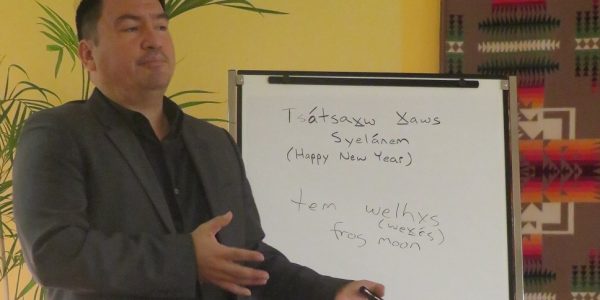Tsatsaxw Xaws Syelanem! Or “happy new year” in the Squamish language.
Our team at Aboriginal Health wanted to know how the new year is celebrated by the nations in our region. Do the Coast Salish nations identify a new year? What distinguishes the new year from the past year? How is it observed? We asked Chief Ian Campbell of Squamish nation to meet with VCH staff and to share some of the customs of the land we are living in.
Lunar calendar
The people of Squamish nation and across the Coast Salish region follow the lunar calendar and it’s the new moon in February that starts the cycle again. Chief Ian described the interrelationship of the cycles of the living world and how they inform the activities and responsibilities of the people. Many of the spring and summer months are named after berries when they are in season and need to be gathered. For example, Tem tsatskay (April) is named after salmon berries.
Around the third week of February, it is Tem welhxs – frog moon, when frogs come out of hibernation and start singing again that signals that winter is ending and spring is coming.
Knowledge of this calendar has been a process of relearning for Chief Ian. The historical attempt under the Indian Act to eradicate Indigenous nations and their ways of life and cultures and to dislocate them from their lands has disrupted the transfer of knowledge between generations.
Winter rites of passage
In Squamish culture, winter is a time for reflection and ceremony. Many of the rites-of-passage ceremonies, marriages, funerals, memorials, and other official events which served to redistribute wealth and replenish the Squamish social safety occurred in winter. The Squamish are a longhouse people, and these important events happen in longhouse ceremonies held throughout the winter season in preparation for the new year.
One of the types of ceremonies that Chief Ian shared with staff was rites of passage. To bring adolescents into the next stage of their development and into their new social roles and responsibilities, rites of passage help them kwayatsut (to find one’s power). A direct English translation does not exist, so Chief Ian described that each person is believed to have syewen (a unique essence or power). The youth go through tests of strength that teach them to overcome their fears, helps them understand their own strength, and to connect with and understand their syewen.
At the end of this process, each young person receives their own dance, names and regalia. There are also many teachings that go with these regalia, songs, and dance ceremonies that would be shared with the youth as they have been for over thousands of years.
We are all now living in Squamish, Tsleil-Waututh, and Musqueam land. Chief Ian says it’s important to share information about our cultural practices with our non-Indigenous neighbours because “our history is now your history too.”


Jillian
Thank you so much for sharing how you celebrate your New Year.
I have found that there are events regarding the First Nations celebrations that are open for all to experience and have a chance to participate.
One of these events is the Hoobiyee 2018 that is being held on Feb 2 & 3, 2018 at the PNE Forum. I will certainly be attending with my children so that they will get a lesson in history too.
http://www.tsamiks.com/hoobiyee-2018.html
Aboriginal Health
Hi Jillian – glad you liked our story. Thanks for sharing this event. If you’d like to find out more about events and current news, you can also follow us on our Facebook page @VCHAH2015